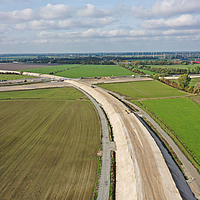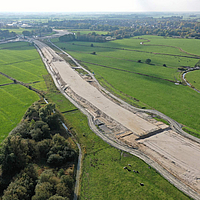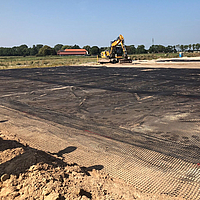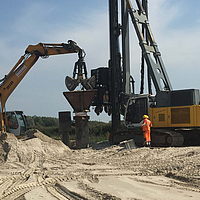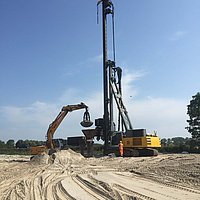Rail expansion JadeWeserPort
Project information
ABS Oldenburg – Wilhelmshaven, PFA 6, Railway relocation Sande
Wilhelmshaven, DE
Deutsche Bahn AG
DB Netz AG Hannover
Strabag AG, Direktion Großprojekte Nord-West Hamburg
2018-2020
Project details
With a handling volume of more than 2 million containers per year, Germany's only deep-water port, JadeWeserPort, places the highest demands on the connection to the supra-regional rail network. An efficient and modern rail infrastructure in this region plays a central role in the fast and environmentally friendly transport of goods in the European region. The properties of the subsoil in the Weser delta and the Jade Bay are highly demanding in terms of construction technology, as the subsoils are largely characterised by peat and clay. Extremely soft soils with high organic content were encountered on the east of the municipality of Sande, where the construction of an approximately 6 km long double-track railway line is planned to relieve the village of freight traffic.
For soil improvement below the railway embankments, the load-bearing system of geosynthetic-encased sand columns is used. The system was specially developed for use in challenging geological conditions. The system consists of evenly spaced columns of non-cohesive material with a high modulus geosynthetic casing. The effect from the railway embankment and the traffic load cause radial outward horizontal stresses within the column. These stresses are counteracted not only by the earth pressure of the soft soil layer, but also by the radial resistance of the casing. Ring tensile forces are mobilised in the casing, which lead to an increase in column stiffness during consolidation and thus to load concentration above the columns. Columns with a diameter of 0.8 m and a length of up to 14 m are placed in a triangular grid using the displacement method.
To improve the load distribution and increase the stability in the railway embankment, geogrids with tensile strengths of up to 1300 kN/m are installed above the column heads.
Thanks to the effective geotextile casing, the columns are not effected by the lateral support effect of the soft layer and are therefore ideally suited for use in extremely soft and organic soils. In contrast to ordinary non-encased columns, the column spacing can often be significantly reduced. In addition to increasing the stability of the embankment during the construction phase and after completion, the significant reduction of absolute as well as differential settlements is a major advantage of the system. The columns can be filled with locally available granular materials, which reduces the effort and cost of transporting of construction materials. In addition, the columns act as filter-stable megadrains, which can accelerate the settlement and consolidation processes and thus significantly shorten the construction phase.

